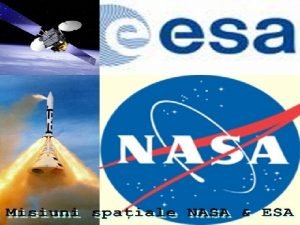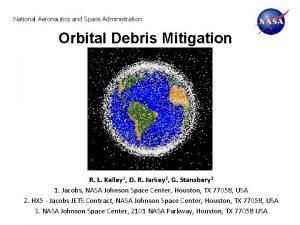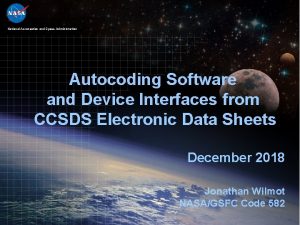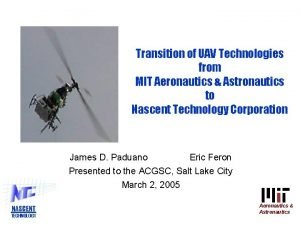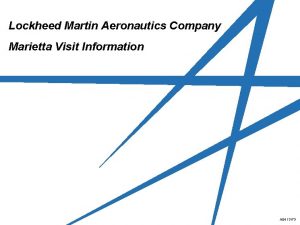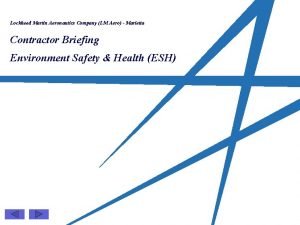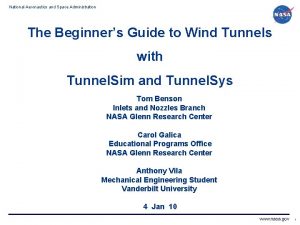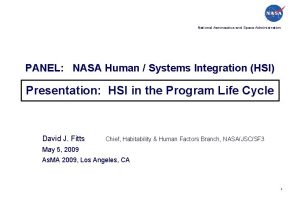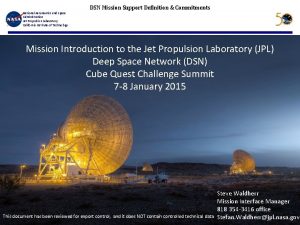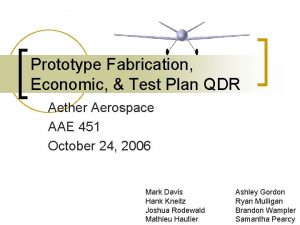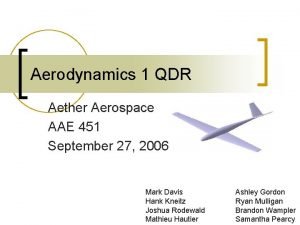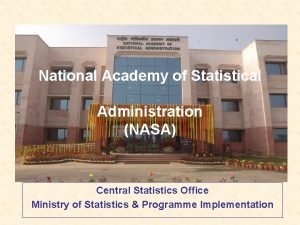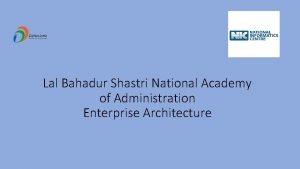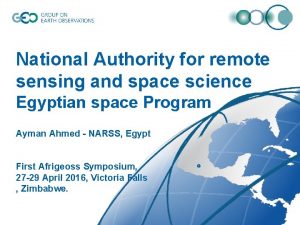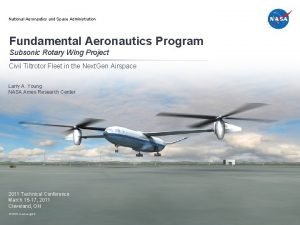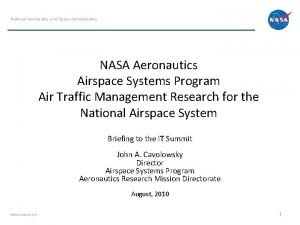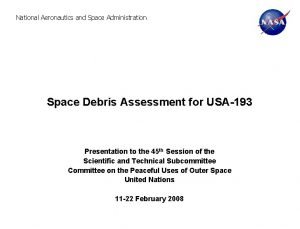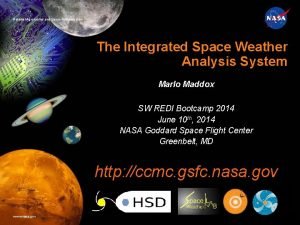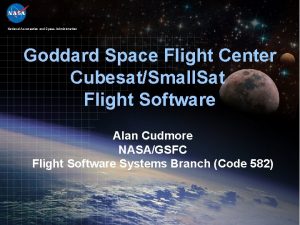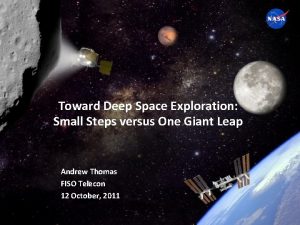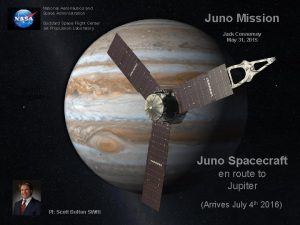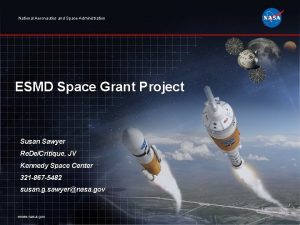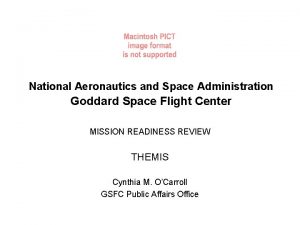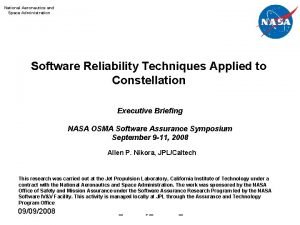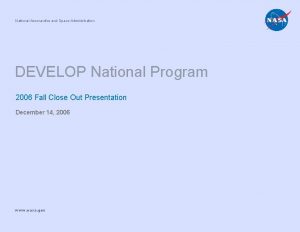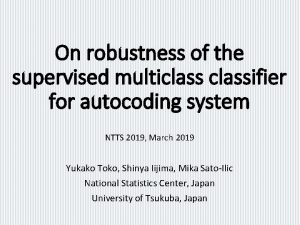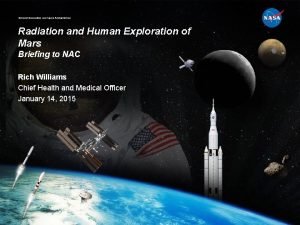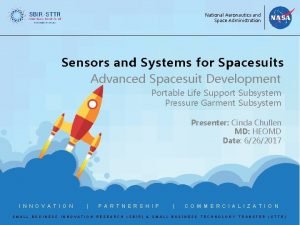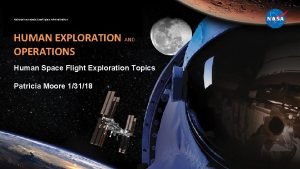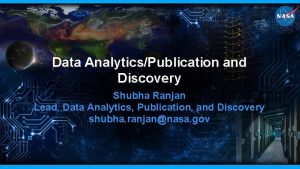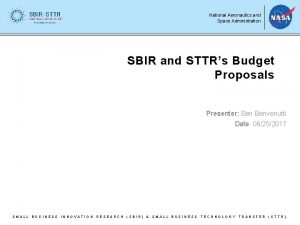National Aeronautics and Space Administration Autocoding Software and



























- Slides: 27

National Aeronautics and Space Administration Autocoding Software and Device Interfaces from CCSDS Electronic Data Sheets December 2018 Jonathan Wilmot NASA/GSFC Code 582 NASA Internal Use Only 1 1

Agenda • Definitions • Overview • State Machines and Activities • Tools for development and Systems Integration • Lunar Orbital Platform - Gateway Use Case • Summary and Status 2 2

Definitions • An Electronic Data Sheet (EDS) is a formal specification of a device, system, or software interface in a machine readable format Unambiguous and machine verifiable specification • Written in Extensible Markup Language (XML) Delivered with the device, (sub)system, or software component It is not an Interface Control Document (ICD) in that it does not specify how a system or mission will use the device or software EDS specifies black box view of interfaces: data formats, conversions, limits, exchange protocols (state machines) An EDS is different from an XML Telemetric and Command Exchange™ (XTCE™) database in that XTCE is targeted to operational command telemetry systems and does not define network stacks or interface interaction patterns 3 3

Electronic Data Sheet Definitions • Consultative Committee for Space Data Systems CCSDS International standards organization • A CCSDS Spacecraft Onboard Interface Services (SOIS) EDS (SEDS) is an EDS defined using the SOIS Dictionary of Terms and the SOIS EDS XML schema Electronic Data Sheets and Common Dictionary of Terms Overview and Rationale (Green 870. 1) XML Specification for Electronic Data Sheets for Onboard Devices and Software Components (Magenta 876. 0) Specification for Dictionary of Terms for Electronic Data Sheets for Onboard Components (Blue 876. 1) SEDS schema and dictionary of terms are keep in SPACE ASSIGNED NUMBER AUTHORITY(SANA) REGISTRY http: //sanaregistry. org/r/sois. html Provides a standard to exchange system, device and software interface definitions between organizations and agencies 4 4

Device and Software Component SEDS Software Component Star trackers Thrusters Sun sensors EDS EDS Software Component EDS Software tools Goal: Device manufactures provide an SEDS with each component 5 5

Development and Operations Current EDS Tool Prototypes Products Models 6 6

Primary Use Cases for Devices • • • Devices are delivered with a SEDS that also contains device specific information, version, serial number, calibrations… SEDS has placeholders for project deployment configuration (MAC address, MIL 1553 RT, … These SEDS will not validate with generic XML tools (XML Spy) SEDS used to autocode interface tests that are run against that specific device to verify compliance to the data sheet prior to shipping SEDS is a input to systems integration tools Flight project can used those tests or autocode test set specific tests to verify the device is compliant and preforms as stated Autocoding of device drivers Autocoding of device models 7 7

Primary Use Cases for Software Components • • Software components are delivered with a SEDS has placeholders for project deployment configuration These SEDS will not validate with generic XML tools (XML Spy) SEDS are configuration managed with the component • SEDS is a input to system integration tools • • These tools create a new SEDS with all the variables populated SEDS are used to autocode integration tests • Any interface changes must be reflected in the SEDS Interface black box (not a unit test) Flight project can used those tests or autocode test set specific tests to verify the component matches it’s EDS interface Autocoding component models in a modeling language 8 8

State Machines and Activities Examples 9 9

State Machine and Activity Diagram Examples from CCSDS interoperability tests UML State Diagram for Get. Extended. Status. Mode 10 10

Complex SEDS State Machine Example State machine in graphical format State transitions in table format 11 11

Tools for Development and Systems Integration 12 12

SEDS Work Flow / Tool Chain (GSFC) 1. Supplied by user Project. Specific Config Project. Specific Test EDS Processor 2. Supplied with c. FS Applications (multiple) EDS (xml) Source Code C Compiler Binaries 3. Intermediate Output Products Test Procedures (Lua) Test Executive (EDS-Lua Bindings) Test Results 4. Final Output Products 13 13

Integration Toolchain Overview CCDD (JSC) Binary Table Files FSW Default Table Definitions Devices Apps EDS Design Parameters Mission - Mnemonics - Constraints c. FS Command Data Dictionary (CCDD) EDS App Table Generator Default Tables EDS c. FE Code Generator Header Files Runtime Data Dictionary SIL & Embedded Coder Model-Based-App Bus Definitions Mission Database In work Subnetwork schedule EDS Runtime Library CCDD tool provides consistent data definitions system wide 14 14

c. FS Command Data Dictionary tool • NASA c. FS Command Data Dictionary tool (CCDD) Database of system data exchange and configuration Auto-generation of design, code, and configuration artifacts Graphical User Interface for viewing and editing Inputs: o Component EDSs o System design parameters Outputs: o Component EDSs (as modified by design parameters) o Ground system databases (XTCE, ITOS) o System configuration files o “C” header files for software components o Parameter table definition files o Bus definitions for modeling tools (Mathworks Simulink) o System documentation 15 15

Lunar Orbital Platform - Gateway Use Case 16 16

Lunar Orbital Platform - Gateway Elements Conceptual View SEDS use with Lunar Orbital Platform - Gateway (LOP-G) international partners with varied tool chains and software architectures Thermal Comm. I/O Vehicle Management Comm. Power Time-Triggered Ethernet Backbone GN&C I/O ECLSS Propulsion 17 17

LOP-G Use Case • Program has international partners potentially using different software architectures Think of it as a International Space Station (smaller) at the Moon • International partners may provide devices to another partners system/subsystem • SEDS defines the formats and interaction patterns of those interfaces SEDS can describe ECSS PUS interfaces and c. FS Software Bus(SB)/Software Bus Network(SBN) interfaces • SEDS includes the full subnetwork stack to access the interface Example: Space Packet -> UDP-> IP -> Ethernet • SEDS is used as input into each partners architecturally specific tool chains SEDS provides the internationally recognized standard to exchange those interface definitions 18 18

Summary and Status • Devices and software components are developed and delivered with a SEDS • The SEDS is an input into tools that generate system configuration, documentation, test procedures, operations procedures and other artifacts • SEDS is an open international standard allowing exchange of interface definitions that can be used in multiple architectures across agencies • Through tooling, devices and software components can be made interoperable • SEDS standards books have completed final agency review and interoperability test and are in the CCSDS queue for publication • SEDS standards books are included in the LOP-G requirements • ESA and NASA are actively developing tools support SEDS in flight projects • Active project to integrate Time-Space Partitioning architecture and timetriggered network (AES funded) • Effort to expand SEDS to cover device thermal and power attributes 19 19

Acronyms 20 20

Backup c. FS SEDS Work Flow Details 21 21

EDS Work Flow: Pre-build 1. Supplied by user Project. Specific Config Project. Specific Test 2. Supplied with c. FS Applications (multiple) EDS (xml) EDS Processor Source Code (C? ) Test Procedures (Lua) EDS processor reads all supplied EDS files from all applications and merges with project configuration Produces C header files that can be directly used (#include'ed) by C source code Produces a runtime database with only basic types and sizes Produces a second database to augment the runtime database with full information including names, display formats, etc. 3. Intermediate Output Products 22 22

EDS Work Flow: Compilation 1. Supplied by user Project. Specific Config Project. Specific Test 2. Supplied with c. FS Applications (multiple) EDS (xml) All source code compiled using generated header files for message formats and enumeration values Binaries may link in only runtime EDS DB (small size) or both DBs (full features) Source Code (C? ) C Compiler Binaries 3. Intermediate Output Products Test Procedures (Lua) Test Results 4. Final Output Products 23 23

EDS Work Flow: Verification 1. Supplied by user Project. Specific Config Project. Specific Test 2. Supplied with c. FS Applications (multiple) EDS (xml) Source Code (C? ) Test procedures written in a procedural language (Lua) specify a sequence of inputs and expected results Tests are based on messages defined in the EDS Combined with project-specific test configuration, tests are executed against running binaries Binaries 3. Intermediate Output Products Test Procedures (Lua) Test Executive (EDS-Lua Bindings) Test Results 4. Final Output Products 24 24

EDS Results: Development Cycle Changes to a any application's EDS get reliably, automatically propagated to all other entities that rely on the definition Debug tools and control systems are always in sync Tedious and error-prone manual propagation is eliminated Improved quality and usability of debug tools Instead of showing binary traces, debug tools can fully decode all messages and show in user-friendly formats Expands options available to developers No longer locked into only developing in “C” EDS can drive bindings to Lua, Perl, Python, Javascript or even more Improves code-sharing opportunities and portability to other platforms Problems such as Space Packet APID conflicts are greatly reduced EDS will detect and report any issues at an early stage 25 25

EDS Results: Run Time Much more runtime code is able to be “common” Historically, each app received messages from the SB and validated them individually based on size and content. Now the validation code is based on the EDS “runtime” DB and can be validated by SB code itself. More complete and consistent message verification with and simpler application code EDS solves many CPU endianness problems EDS “runtime” DB has all needed information in order to reliably byte swap / re-pack messages between a “native” format and a “wire” format Optimized for fast operation in case the wire format matches the native CPU format (pass through) Project can choose which endian to use “on the wire” to best match the architecture of the actual CPUs in use. Swapping/Re-pack done by the “Gateway” application to external devices. No additional code needed in app to support this! 26 26

EDS Results: Verification Greatly improves the ability to perform “black-box” style testing Each app can supply an individual “isolated” test procedure that checks the basic inputs and outputs, independent of deployment details such as APIDs, physical uplink type, or other apps running on the target. Uses Lua, a fully-featured embeddable programming language, so the tests can be as complex as they need to be (variables, if statements, for/while loops, function calls, etc) Actual I/O messages are driven by EDS so they get automatically updated if EDS is ever updated, and they are not specific to any particular target CPU architecture. The project can choose to extend the tests beyond just single-app tests Additional test procedures defined at the top-level can exercise dependencies between running applications and check for the correct system responses. When combined with a simulation environment / virtual target machine, testing can be done frequently in completely automated and repeatable fashion 27 27
 National aeronautics and space administration
National aeronautics and space administration Debris assessment software
Debris assessment software Autocoding device gateway
Autocoding device gateway Mit aeronautics and astronautics
Mit aeronautics and astronautics Department of aeronautics and astronautics
Department of aeronautics and astronautics Electric force
Electric force Lockheed martin slogan
Lockheed martin slogan Tdot aeronautics
Tdot aeronautics Lm aero
Lm aero Define:aeronautics
Define:aeronautics Beginner's guide to aeronautics
Beginner's guide to aeronautics Aeronautics
Aeronautics Aeronautics definition
Aeronautics definition Balloon (aeronautics)
Balloon (aeronautics) Aether aeronautics
Aether aeronautics Maximum lift coefficient formula
Maximum lift coefficient formula National academy for public administration
National academy for public administration National academy of statistical administration
National academy of statistical administration National highway safety administration reviews
National highway safety administration reviews Miramar national cemetery grave locator
Miramar national cemetery grave locator Lal bahadur shastri national academy of administration
Lal bahadur shastri national academy of administration National space research and development agency
National space research and development agency National authority for remote sensing and space sciences
National authority for remote sensing and space sciences Unscented trajectory chapter 5
Unscented trajectory chapter 5 Space junk the space age began
Space junk the space age began Camera space to world space
Camera space to world space Unscented trajectory chapter 5
Unscented trajectory chapter 5 World space computer
World space computer
